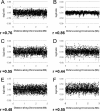Phylogenetic, microbiological, and glycoside hydrolase diversities within the extremely thermophilic, plant biomass-degrading genus Caldicellulosiruptor
- PMID: 20971878
- PMCID: PMC3008241
- DOI: 10.1128/AEM.01400-10
Phylogenetic, microbiological, and glycoside hydrolase diversities within the extremely thermophilic, plant biomass-degrading genus Caldicellulosiruptor
Abstract
Phylogenetic, microbiological, and comparative genomic analyses were used to examine the diversity among members of the genus Caldicellulosiruptor, with an eye toward the capacity of these extremely thermophilic bacteria to degrade the complex carbohydrate content of plant biomass. Seven species from this genus (C. saccharolyticus, C. bescii, C. hydrothermalis, C. owensensis, C. kronotskyensis, C. lactoaceticus, and C. kristjanssonii) were compared on the basis of 16S rRNA gene phylogeny and cross-species DNA-DNA hybridization to a whole-genome C. saccharolyticus oligonucleotide microarray, revealing that C. saccharolyticus was the most divergent within this group. Growth physiology of the seven Caldicellulosiruptor species on a range of carbohydrates showed that, while all could be cultivated on acid-pretreated switchgrass, only C. saccharolyticus, C. bescii, C. kronotskyensis, and C. lactoaceticus were capable of hydrolyzing Whatman no. 1 filter paper. Two-dimensional gel electrophoresis of the secretomes from cells grown on microcrystalline cellulose revealed that the cellulolytic species also had diverse secretome fingerprints. The C. saccharolyticus secretome contained a prominent S-layer protein that appears in the cellulolytic Caldicellulosiruptor species, suggesting a possible role in cell-substrate interactions. Growth physiology also correlated with glycoside hydrolase (GH) and carbohydrate-binding module (CBM) inventories for the seven bacteria, as deduced from draft genome sequence information. These inventories indicated that the absence of a single GH and CBM family was responsible for diminished cellulolytic capacity. Overall, the genus Caldicellulosiruptor appears to contain more genomic and physiological diversity than previously reported, and this argues for continued efforts to isolate new members from high-temperature terrestrial biotopes.
Figures




References
-
- Altschul, S. F., W. Gish, W. Miller, E. W. Myers, and D. J. Lipman. 1990. Basic local alignment search tool. J. Mol. Biol. 215:403-410. - PubMed
-
- Bayer, E. A., J. P. Belaich, Y. Shoham, and R. Lamed. 2004. The cellulosomes: multienzyme machines for degradation of plant cell wall polysaccharides. Annu. Rev. Microbiol. 58:521-554. - PubMed
-
- Bergquist, P., D. G. Moreland, D. M. Daniel, V. S. J. Te'o, J. S. David, and W. M. Hugh. 1999. Molecular diversity of thermophilic cellulolytic and hemicellulolytic bacteria. FEMS Microbiol. Ecol. 28:99-110.
-
- Bielen, A. A. M., K. Willquist, J. Engman, J. van der Oost, E. W. J. van Niel, and W. M. K. Servé. 2010. Pyrophosphate as a central energy carrier in the hydrogen-producing extremely thermophilic Caldicellulosiruptor saccharolyticus. FEMS Microbiol. Lett. 307:48-54. - PubMed
Publication types
MeSH terms
Substances
Associated data
- Actions
- Actions
- Actions
- Actions
- Actions
- Actions
- Actions
- Actions
- Actions
- Actions
- Actions
- Actions
LinkOut - more resources
Full Text Sources
Other Literature Sources
Molecular Biology Databases

